- About Us
- Our Work
- Tree Info
- Get Involved
- Blog
- Volunteer
- Support Us
By Canopy Team on February 25, 2019
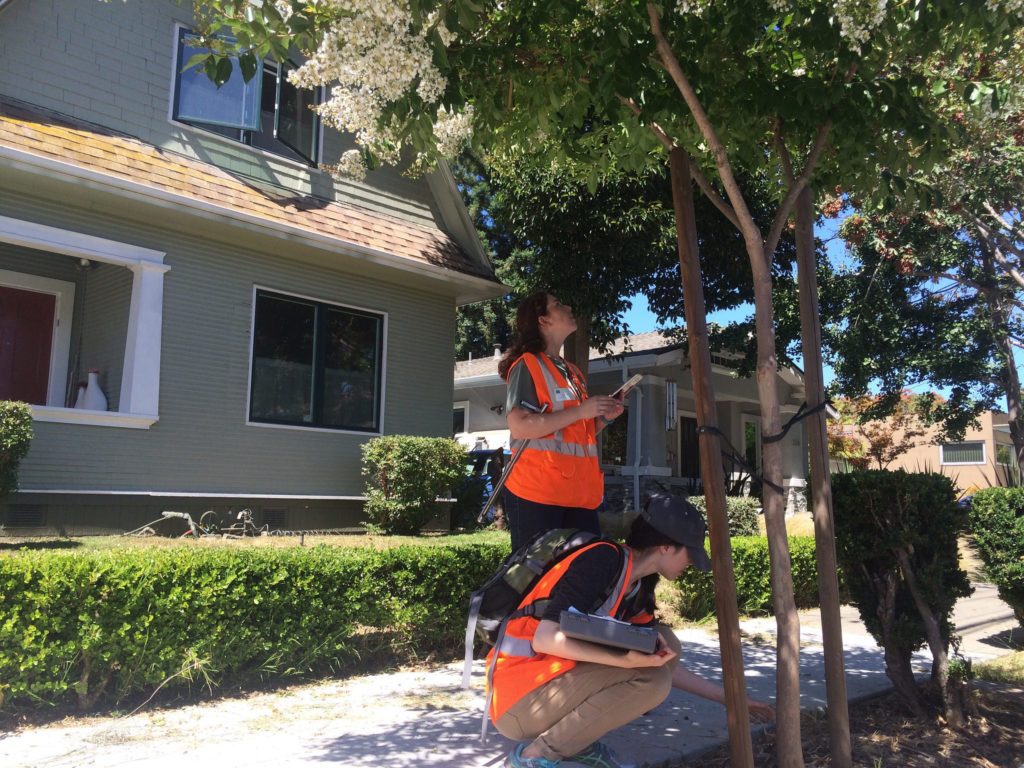
Welcome to Canopy’s Ask the Arborist blog series that features tree care tips and expert advice from local certified arborists. Check out other posts in the series: Tips for when you’re hiring an arborist and Root defects: secret flaws that can kill your young tree.
It is not uncommon for humans to develop almost spiritual connections with trees. Like humans, they are long lived organisms, which sometimes grow old right alongside us. It’s hard to not see the beauty in watching a tree grow from a sapling and eventually into a mature version of its species.
This life cycle, can be longer or shorter than that of a human being, but has many of the same struggles. I believe this similarity may be one reason why we can form such bonds with them. Trees have it rough because they are not able to move around as we can or yell out when afflicted. Changes to their rooting environment, abnormal precipitation levels, invading insects and pathogens, and much more, are all issues they have to either deal with or fall victim to. This is where we can help!
In nature, life for a tree is quite literally survival of the fittest. In our urban forest, this can also be the case, but an educated property owner can make a large difference by simply knowing what an upset tree looks like. This is not only valuable in saving a tree’s life, but could also aid in keeping our community safer.
Trees will often give us warning signs before falling down or suffering a structural failure that could damage property or even take a life. The first step in knowing when something may be changing with your tree, is to first be aware of what is normal. Keep a watchful eye on your trees so you can form a baseline of how thick the canopy is, what the normal color of green is for the foliage, and other miscellaneous features. Focusing too hard can be a different problem, altogether, but having some idea of what is normal will help you know whether it’s time to call an arborist or if what you’re seeing is just a seasonal change.
As you become more familiar with your trees, you’ll begin to recognize others of the same species within your community. With time, you should begin to better pick up on what’s a natural variation within that species and what could be a real problem.
Canopy thinning or defoliation: This can represent a lot of different issues, but a damaged root system is one of the most common and problematic. Root rot is a common term for when a tree’s root system is being destroyed by a fungus. A thinning canopy and advanced root rot go hand in hand. As the root system is being damaged, the trees ability to feed its above ground body, declines.
This is a problem because not only can prolonged root rot lead to complete canopy die off, but is also a large concern from a structural perspective. Tables without legs cannot stand! And trees without roots can fall over. The issue could be something else but if you think the canopy is considerably thinner than it has been, just call an arborist and have it checked out. Sometimes, we can reverse the trees course before it’s too late.
Bleeding: Any sort of liquid material that is oozing from a tree, may or may not be something to be concerned with. Bacterial infections, wood decay fungi, insects, and all sorts of other causes may be to blame.
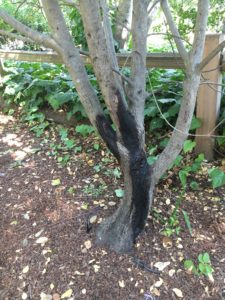
Buckthorn with trunk bleeding
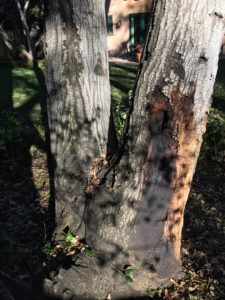
Coast Live Oak with trunk bleeding
Fungus: The signs of a fungal presence can vary wildly. We most often see a fungus by the exhibition of its fruiting body. Mushrooms, conks (shelf fungus) and all other sorts of weird growths can pop up above ground or directly from a piece of wood, when the pathogen is attempting to reproduce.
There are an unbelievable amount of fungal pathogens and most are no problem. When you may need to worry is if you see them growing directly from a tree and especially right at the base. Since the identification of fungus can be so complicated, it’s best to have it checked out by a professional. Snapping a picture may be a good idea, as well, since critters and the natural decay process can make fungal fruiting bodies disappear quite quickly.
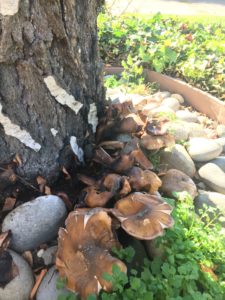
Birch tree with fungal fruiting bodies at base
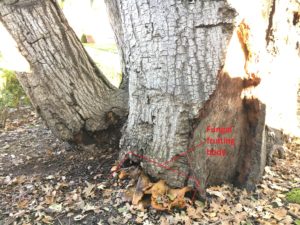
Coast Live Oak with fungal fruiting body at base
Holes or fine powder deposits: There is an entire class of insects that eat through the woody portion of trees, most often referred to as “wood boring insects” or “Bark beetles”. These bugs will usually leave holes in the bark that can range from the size of a pencil tip or bigger than an eraser.
Near these holes you may find “frass”, which can look like a fine powder or coarse granular. Frass is basically the excrement of beetles. As the insect bores through the wood, frass comes out behind them. Some wood boring insects are fairly common and not a huge concern and others can be deadly to your trees. It’s best to have this one checked out quickly.
Yellowing foliage: When leaves turn yellow, it can be due to the lack of a vital pigment in leaves, named chlorophyll. Without proper chlorophyll production, leaves will struggle to make the sugars needed for survival. It’s all a part of that amazing process we call.. *drumroll*… PHOTOSYNTHESIS!
The yellowing of foliage, or chlorosis, can be a result of insect attacks, nutrient deficiencies, too much water, not enough… or it may be nothing, at all. Again, knowing what’s normal for your tree is important here.
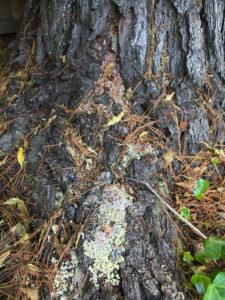
Monterey Pine with frass at base, resulting from wood boring insect

Camelia with healthy foliage at right, severe chlorosis to the left
Poor tree structure: Some issues with trees may not be linked to the trees health, or at least not in a negative way. Many of our urban trees are not native to this region. This can cause them to take on shapes that are a-typical for the species or cause them to grow at an abnormal rate.
For example, a tree that has evolved for millennia to grow in a tight forest with other trees, will often be tall, skinny, and slower growing due to competition. That same tree that is grown in full sun in a front yard with lots of irrigation, may grow faster and get much wider than it can handle. This situation develops a tree that is healthy, yet falling apart due to poor structure. Every species of tree has a unique structure, for this reason and many others, it is a great idea to do an annual walk around your property with an arborist who can help you get to know your trees.
Most large urban trees will need some sort of structural maintenance to keep them from falling apart under their own weight. It is important that you know what a heavy branch looks like for each species, and what pruning schedule is normal to keep things in proper shape. Also, features like bad branch connections or undesirable growth forms can be identified and dealt with before it’s too late.
If you work with an arborist who matches your personality well and who you can learn from, you’ll be able to learn a bit more each time and better assess your trees, on your own. The best observations are made with an educated mind! Observe, read, listen, and care. Our urban forest depends on it!
Visit Canopy’s Arborist List to find local arborists and tree care companies.
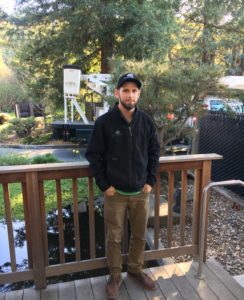
Jason Shirar, has been working in the tree care industry for six years and is currently employed in the bay area by S.P. McClenahan Arboriculturists. He spent three years, during and after college, working on tree crews to become familiar with not only the science, but also the physical side of arboriculture. His credentials include a Bachelors Degree in Urban Forest Management, ISA Certified Arborist, QAL License holder (for pesticide usage), TCIA member, and a 2015 graduate of the Davey Institute of Tree Science. He also serves on the Tree Care Subcommittee for Canopy and volunteers for various events each year.